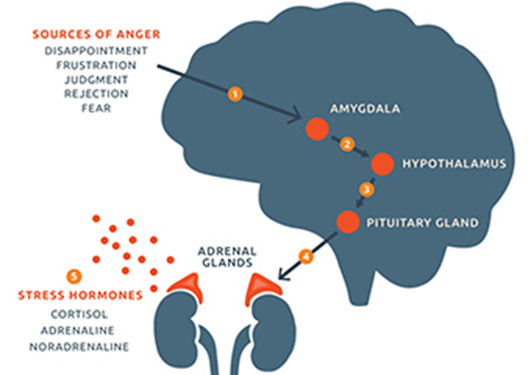A nurse is caring for a client admitted to the emergency room exhibiting impulsive behaviors of rage and anger. Dysfunction in which brain structure contributes to this behavior?
Cerebellum
Basal Ganglia
Spinal Cord
Hypothalamus
The Correct Answer is D
A. Cerebellum: The cerebellum is primarily involved in motor coordination, balance, and muscle tone regulation. Dysfunction in the cerebellum is more likely to result in motor coordination problems rather than impulsive behaviors of rage and anger.
B. Basal Ganglia: The basal ganglia are a group of nuclei in the brain involved in motor control, learning, emotion, and cognition. Dysfunction in the basal ganglia can lead to movement disorders such as Parkinson's disease but is also associated with impulsive behaviors, including rage and anger.
C. Spinal Cord: The spinal cord primarily functions in transmitting sensory and motor signals between the brain and the rest of the body. Dysfunction in the spinal cord typically results in sensory or motor deficits rather than impulsive behaviors like rage and anger.
D. Hypothalamus: The hypothalamus plays a crucial role in regulating emotions, autonomic functions, hormone production, and homeostasis. Dysfunction in the hypothalamus can lead to disruptions in emotional regulation, including impulsive behaviors such as rage and anger.

Nursing Test Bank
Naxlex Comprehensive Predictor Exams
Related Questions
Correct Answer is C
Explanation
A. Gamma-aminobutyric acid (GABA) and acetylcholine: GABA is an inhibitory neurotransmitter that helps regulate neuronal excitability. It is not typically implicated in depression. Acetylcholine plays a role in cognitive functions and muscle contractions but is not primarily associated with depression.
B. Glutamate and histamine: Glutamate is the primary excitatory neurotransmitter in the central nervous system, and its imbalance has been linked to various neurological disorders, but it is not directly implicated in depression. Histamine, known for its role in allergic responses and wakefulness, is not typically associated with depression.
C. Norepinephrine and serotonin: Both norepinephrine and serotonin are monoamine neurotransmitters that play crucial roles in mood regulation. Decreased levels of these neurotransmitters have been strongly linked to depression. Norepinephrine is involved in the body's stress response and arousal, while serotonin is involved in mood, sleep, appetite, and other functions.
D. Serotonin and acetylcholine: Serotonin, as mentioned earlier, is significantly implicated in depression due to its role in regulating mood and emotional states. Acetylcholine, while important for cognitive functions and muscle control, is not primarily associated with depression.
Correct Answer is D
Explanation
A. Psychiatric Nurse: Psychiatric nurses primarily focus on providing direct care to patients with mental health disorders, including medication management, psychoeducation, and therapeutic interventions. While they may participate in interpreting test results and contributing to the overall care plan, their role in psychological test interpretation and therapy design is typically more supportive or collaborative within the interdisciplinary team.
B. Psychiatrist: Psychiatrists are medical doctors specializing in mental health. They are trained to diagnose mental health disorders, prescribe medication, and provide psychotherapy. While they may interpret psychological test results as part of their diagnostic process, their main focus is on medical management, including medication adjustments and monitoring.
C. Recreation Therapist: Recreation therapists focus on using recreational and leisure activities as therapeutic interventions to improve patients' physical, emotional, cognitive, and social functioning. They may not typically be involved in interpreting psychological test results or designing specific therapies related to bipolar disorder.
D. Psychologist: Psychologists specialize in psychological testing, assessment, and psychotherapy. They are trained to interpret psychological tests and assessments, such as those completed for the client with bipolar disorder, and participate actively in designing psychotherapeutic interventions based on these assessments.
Whether you are a student looking to ace your exams or a practicing nurse seeking to enhance your expertise , our nursing education contents will empower you with the confidence and competence to make a difference in the lives of patients and become a respected leader in the healthcare field.
Visit Naxlex, invest in your future and unlock endless possibilities with our unparalleled nursing education contents today
Report Wrong Answer on the Current Question
Do you disagree with the answer? If yes, what is your expected answer? Explain.
Kindly be descriptive with the issue you are facing.
